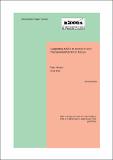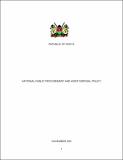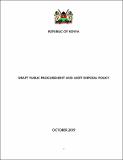Discussion Paper No. 65 of 2006 on Supporting MSEs to Access Public Procurement Market in Kenya
View/
Publication Date
2006Author
Type
KIPPRA Publicationsviews
downloads
Metadata
Show full item recordBy
Njiraini, Peter & Moyi, Eliud
Abstract/
Whereas market access remains a major growth factor, most MSEs in Kenya face formidable market-related constraints. Although the public procurement market is huge, estimated at 9.07 percent of GDP (or Ksh 71 billion), it is dominated by large enterprises at the exclusion of MSEs. It was in view of this fact that Sessional Paper No. 2 of 2005 on Development of Micro and Small Enterprises for Wealth and Employment Creation for Poverty Reduction introduced an affirmative policy of reserving 25 percent of all Government procurement and tenders to the MSE sector. However, this policy proposal is yet to be translated into implementable strategies and guidelines. In addition, it is not supported by an enabling business environment and lacks an accompanying legislation, as is the practice in countries with established affirmative pubic procurement programmes for MSEs. All these shortfalls make it doubtful that MSEs in Kenya would take due advantage of the provisions in the Sessional Paper. This study picks cue from this shortcoming and attempts to tackle the question: How can MSEs be integrated into the public procurement system? There are significant market and institutional failures that discriminate against MSEs in public procurement. The institutional framework is heavily biased towards attainment of efficiencies, transparency and economy of the process at the expense of mainstreaming MSEs into public procurement market. The legal framework has not significantly changed the barriers to their participation. Specific barriers to MSE participation include technical documentation requirements, slow payment, contract aggregation, costly appeal systems, inaccessibility of procurement information, limited capacity, and tender security, among others.
Subject/
Procurement; Procurement Methods; Procurement Barriers; Micro-Privatization; Tender Information
Publisher
The Kenya Institute for Public Policy Research and Analysis (KIPPRA)Series
DP/65/2006Collections
- Discussion Papers [343]
Related items
Showing items related by title, author, creator and subject.
-
Discussion Paper No. 62 of 2006 on Public Sector Procurement in Kenya: The Need for a Coherent Policy Framework
Owegi, Fred & Aligula, Eric (The Kenya Institute for Public Policy Research and Analysis, 2006)Persistent controversies in Kenya's public procurement and the resultant negative impacts on efficient public service delivery can be explained, in part, by weak enforcement of the existing legislation. A coherent public ... -
National Public Procurement and Asset Disposal Policy 2020
The National Treasury and Planning (The National Treasury and Planning, 2020-11)The National Public Procurement and Asset Disposal Policy has been developed in Kenya in line with international standards and the Constitution of Kenya, with the objective of achieving a fair, transparent, and cost-effective ... -
Public Procurement and Asset Disposal Policy 2019
The National Treasury and Planning (The National Treasury and Planning, 2019)The Public Procurement and Asset Disposal System in Kenya has evolved from a system which had no regulations to a legally regulated procurement and asset disposal system in line with International Standards. The Government ...




